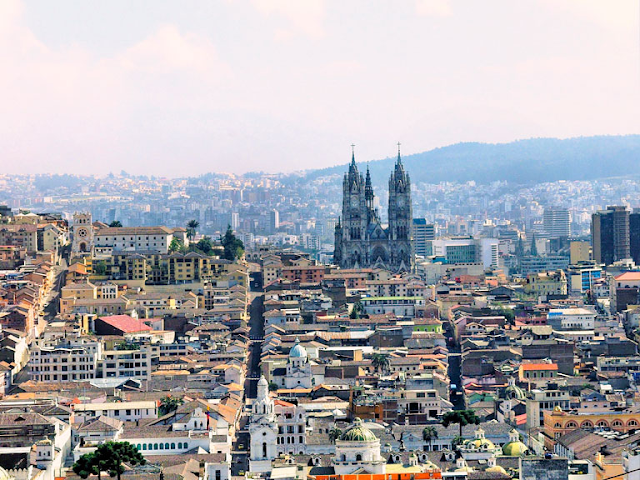Quito: Where History Meets the Sky
Nestled high in the Andean foothills at 2,850 meters (9,350 feet), Quito, the capital of Ecuador, is a city that will literally take your breath away – both figuratively and literally. As the second-highest capital city in the world, its dramatic setting in a valley flanked by volcanic peaks provides a stunning backdrop to a city brimming with history, culture, and vibrant energy. Quito proudly boasts one of the best-preserved and least altered historic centers in Latin America, earning it the prestigious title of a UNESCO World Heritage Site, the first city to receive this honor alongside Krakow.
Stepping Back in Time: The Enchanting Old Town
Quito's Centro Histórico is a captivating maze of cobblestone streets, grand plazas, and magnificent colonial architecture that whispers tales of centuries past. Founded in the 16th century on the ruins of an ancient Inca city, its rich history is palpable at every turn. Must-see landmarks include:
- Plaza Grande (Plaza de la Independencia): The heart of the Old Town, this lively square is surrounded by significant buildings such as the Presidential Palace, the Metropolitan Cathedral, the Municipal Palace, and the Archbishop's Palace. Witness the changing of the guard at the Presidential Palace on Mondays at 11 am.
- Iglesia de San Francisco: Quito's first church and one of its largest colonial structures, this impressive Baroque-style complex dates back to the 16th century and houses a fascinating museum. Don't miss the chance to climb its bell tower for panoramic views.
- La Compañía de Jesús: Often hailed as one of the most beautiful churches in Latin America, this Jesuit church is a breathtaking masterpiece of Baroque art with an incredibly ornate and gilded interior. Photography is not permitted inside, but the sheer opulence is unforgettable.
- Basílica del Voto Nacional: An imposing neo-Gothic basilica with striking towers that dominate the city's skyline. For a small fee, you can climb the towers for incredible panoramic views of Quito and the surrounding mountains. Keep an eye out for the Ecuadorian animals carved as gargoyles!
- Calle La Ronda: A charming and historically significant cobblestone street lined with colorful colonial houses, artisan shops, cafes, and restaurants. It comes alive at night with music and a bohemian atmosphere, offering a taste of traditional Quiteño life.
- El Panecillo: A prominent hill in the middle of Quito crowned by a towering aluminum statue of the Virgin of Quito. Climb to the top (you can even go inside the statue for a small fee) for breathtaking 360° views of the city.
Consider joining a free walking tour to get an excellent introduction to the Old Town's history and hidden gems.
Beyond the Colonial Walls: Modern Quito and Natural Wonders
While the historical center is a major draw, Quito offers much more to explore:
- TelefériQo: Take a scenic cable car ride up the slopes of the Pichincha Volcano to the Cruz Loma viewpoint. From here, you'll be rewarded with breathtaking panoramic views of the city, surrounding Andean peaks, and on a clear day, even distant snow-capped volcanoes. There are also hiking trails at the top for those seeking a bit of adventure.
- Mitad del Mundo (Middle of the World): Located just north of Quito, this iconic site marks the Equator. Stand with one foot in the Northern Hemisphere and the other in the Southern Hemisphere! There are two main sites: the official monument and the Intiñan Museum, which offers interactive exhibits on the equatorial line and Ecuadorian culture.
- La Mariscal: Quito's vibrant modern district, known for its lively nightlife, restaurants, bars, and artisan markets (like the Mercado Artesanal La Mariscal). It's a popular spot for backpackers and younger travelers.
- Parks and Green Spaces: Escape the urban bustle in one of Quito's many parks. Parque La Carolina is a large urban park with a lake, running tracks, and recreational facilities. Parque Metropolitano Guangüiltagua, Quito's largest park, offers extensive forests, walking trails, and stunning views. The Botanical Garden within Parque La Carolina showcases Ecuador's diverse flora.
- Museums and Cultural Centers: Delve deeper into Ecuadorian art and history at museums like the Casa Museo Guayasamín, dedicated to the works of renowned Ecuadorian artist Oswaldo Guayasamín, and the Museo Casa del Alabado, which houses an impressive collection of pre-Columbian artifacts.
A Taste of Quito
Quito's culinary scene offers a delightful blend of traditional Ecuadorian flavors and international influences. Be sure to try local specialties such as locro de papa (potato soup with cheese and avocado), fritada (fried pork), and fresh trout. Explore the Mercado Central for a vibrant experience and sample local fruits and dishes. Quito also has a growing craft beer scene, with several breweries offering unique local brews.
Planning Your Trip
Quito enjoys a mild, year-round spring-like climate due to its high altitude and equatorial location. However, be prepared for variable weather, with sunny mornings often followed by afternoon showers. Layers are essential! The dry season, generally from June to September, is often considered the best time to visit for outdoor activities.
Mariscal Sucre International Airport (UIO) serves Quito with direct flights from many international destinations. Getting around Quito is relatively easy with taxis, buses, and the modern Metro system. Be aware of altitude sickness upon arrival and take it easy on your first day, stay hydrated, and avoid heavy meals and alcohol.
Quito is generally a safe city for tourists, but it's always wise to be aware of your surroundings and take precautions against petty theft, especially in crowded areas.


